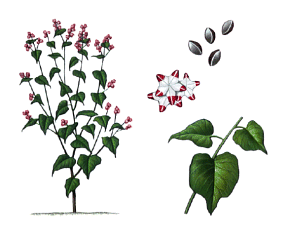

|
CULINARY INFO
|
"DISCLAIMER"
|
Probably native to China, its seeds are roasted and made into flour which is used in pancakes, crisp thin cakes and noodles called sobs in the far east. Buckwheat groats, or kasha are used in soups.
Buckwheat, Fagopyrum esculentum, is an herb belonging to the family Polygonaceae and is not, as popularly believed, a cereal grain. Native to central Asia, buckwheat has been cultivated in China, Turkey, and Russia since the 10th century but was not introduced into Europe and North America until centuries later.
The buckwheat plant is shallow-rooted, grows rapidly to a height of 61-122 cm (2-4 ft), and produces extensive branches and small, white clusters of flowers from a single stem. The seeds are three-cornered. The plant is not usually damaged by diseases or insects and is often planted on non-productive soil. On good soil and in a favourable environment, it does not yield as much as cereal grains. Buckwheat is planted and harvested in the manner of cereal grains.
Buckwheat production is largely confined to Europe and North America, but nowhere is it a major crop. The major countries producing buckwheat are Russia, France, Poland, and Canada. New York, Pennsylvania, Michigan, and Minnesota are the main producers in the United States. Approximately two-thirds of the production is used on the farm, almost all as feed, but some is ploughed under for soil improvement. For human consumption, buckwheat is processed in much the same way as wheat flour. Buckwheat flour is used mainly for pancake mixes or for buckwheat noodles. The farina, the coarser flour particles plus the groat, can be used for breakfast foods, soups, porridge, and gravy. Buckwheat feed, a by-product of milling, is a mixture of middlings and hull. The hulls constitute about 18 to 25 percent of the kernel but have little feed value and are usually used as fuel, bedding for livestock, or packing material.

The buckwheat plant, Fagopyrum esculentum, a herb that is grown as a cereal crop, has broad leaves and small, five-parted flowers. Its three-cornered seeds are ground for pancake flour and groats, and its blossoms are a source of strong, dark honey.
